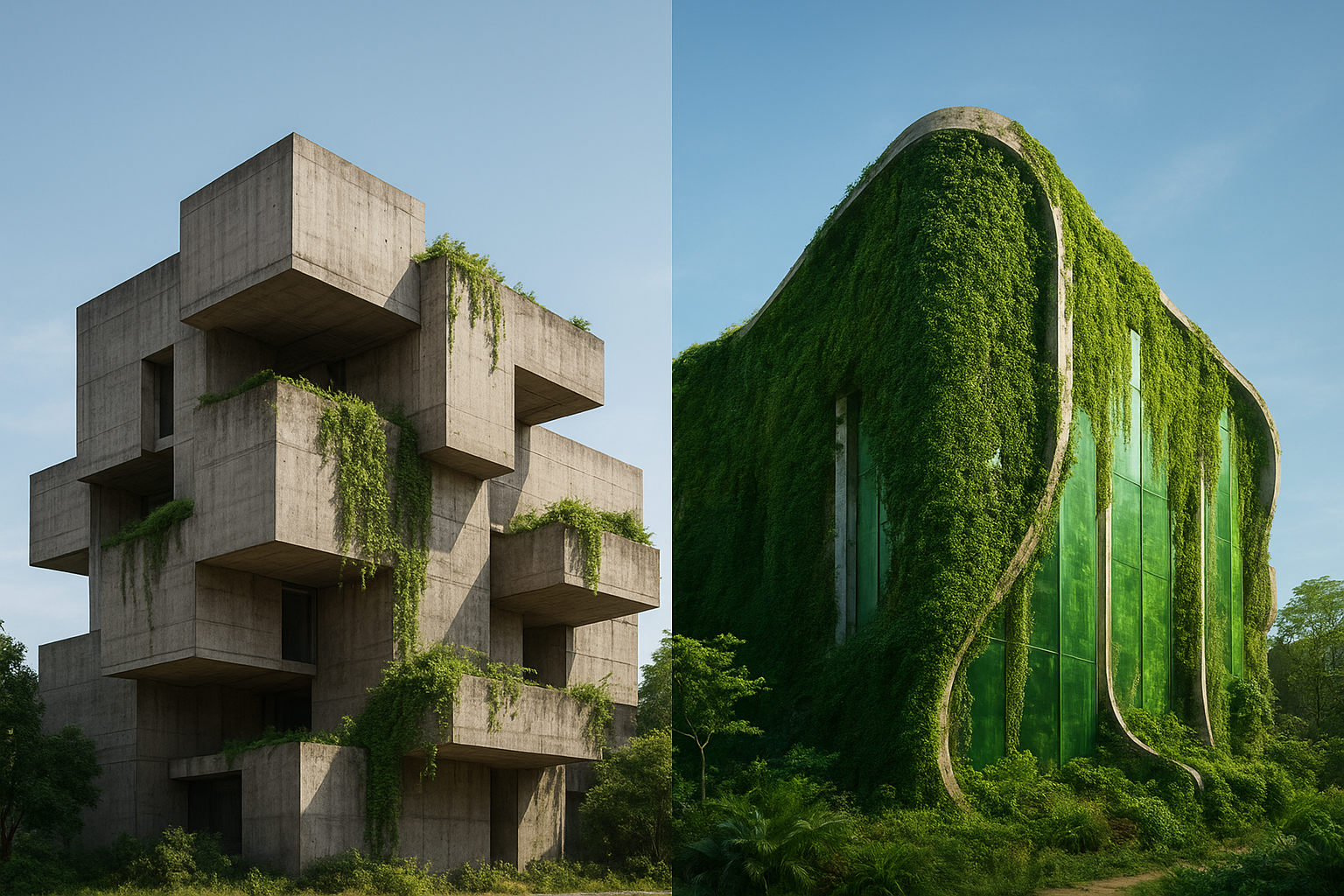As sustainability becomes central to architectural practice, two design movements are shaping the conversation: eco-brutalism and biodesign. These approaches, though visually and philosophically distinct, both address the urgent need for buildings that are resilient, low-carbon, and ecologically integrated. In this article, we’ll explore how architects can leverage eco-brutalism and biodesign in sustainable architecture—and why blending the two may define the future of design.

What is Eco-Brutalism in Sustainable Architecture?
Eco-brutalism is a modern evolution of the mid-century Brutalist style, known for massive geometries, raw concrete, and functional honesty. Today, architects are reimagining brutalism through a sustainable lens by incorporating:
-
Reclaimed concrete & low-carbon cement to reduce embodied carbon.
-
Passive design strategies, using thermal mass for natural heating and cooling.
-
Green integrations like vertical gardens, rooftop biodiversity hubs, and planted terraces.
-
Durable design that extends building lifespans, reducing waste over time.
This movement shows that sustainable architecture doesn’t always need to look light or organic—strength and ecological responsibility can coexist.
What is Biodesign in Architecture?
Biodesign represents the other end of the spectrum. Instead of permanence, it emphasizes adaptability, living systems, and regenerative materials. Biodesign often involves:
-
Mycelium bricks as carbon-neutral, biodegradable alternatives to concrete.
-
Algae façades that generate renewable energy while absorbing CO₂.
-
Living walls and roofs that mitigate urban heat islands and support biodiversity.
-
Self-healing concrete, infused with bacteria, that naturally repairs cracks.
Biodesign is more than sustainable—it is regenerative, asking what happens if buildings don’t just reduce harm but actively heal ecosystems.
Eco-Brutalism vs. Biodesign: Tension & Synergy
At first glance, the movements seem opposed:
-
Eco-brutalism = hard, permanent, monumental
-
Biodesign = soft, adaptive, living
But in practice, their synergy creates innovation:
-
Hybrid architecture: Brutalist structures wrapped in living green façades.
-
Material layering: Combining reclaimed concrete with biomaterials.
-
Resilient cities: Buildings that are both durable and responsive to climate challenges.
This balance allows architects to move beyond aesthetics toward long-term ecological resilience.
Why Eco-Brutalism & Biodesign Matter for Architects in 2025
As the demand for net-zero and climate-resilient architecture accelerates, architects face increasing pressure to innovate. Both eco-brutalism and biodesign provide pathways forward:
-
Eco-brutalism → robust, low-carbon permanence
-
Biodesign → living, regenerative adaptability
Together, they offer architects a new design toolkit to meet client expectations, regulatory demands, and environmental imperatives.
How Architects Can Integrate These Sustainable Trends
-
Explore low-carbon concrete alternatives in new projects.
-
Test biodesign materials like mycelium, algae, or bacteria-enhanced concrete.
-
Partner with landscape architects and biotechnologists for interdisciplinary design.
-
Balance durability with adaptability, blending the permanence of eco-brutalism with the resilience of biodesign.
The future isn’t either/or—it’s both/and.
👉 Where Chrometa Fits In
At Chrometa, we know that innovation takes time. Architects balancing design research, client projects, and sustainable experimentation need seamless ways to capture every billable hour. With Chrometa’s automatic time tracking for architects, you can stay focused on creating the future of sustainable architecture while ensuring your work is valued.
Similar Stories
Enterprise
5 Resources to Boost Your Freelance Productivity
The modern freelancer has a lot of plates to spin on a daily basis in order to succeed – and there never seems to be enough hours in the day. Those that use their limited time most efficiently will blow past the competition and make an impact in their chosen market. . Read More
Enterprise
6 Tips to Maintain a Healthy Work-Life Balance during COVID
Confinement, lockdown, quarantine, shelter-in-place… .... Read More


